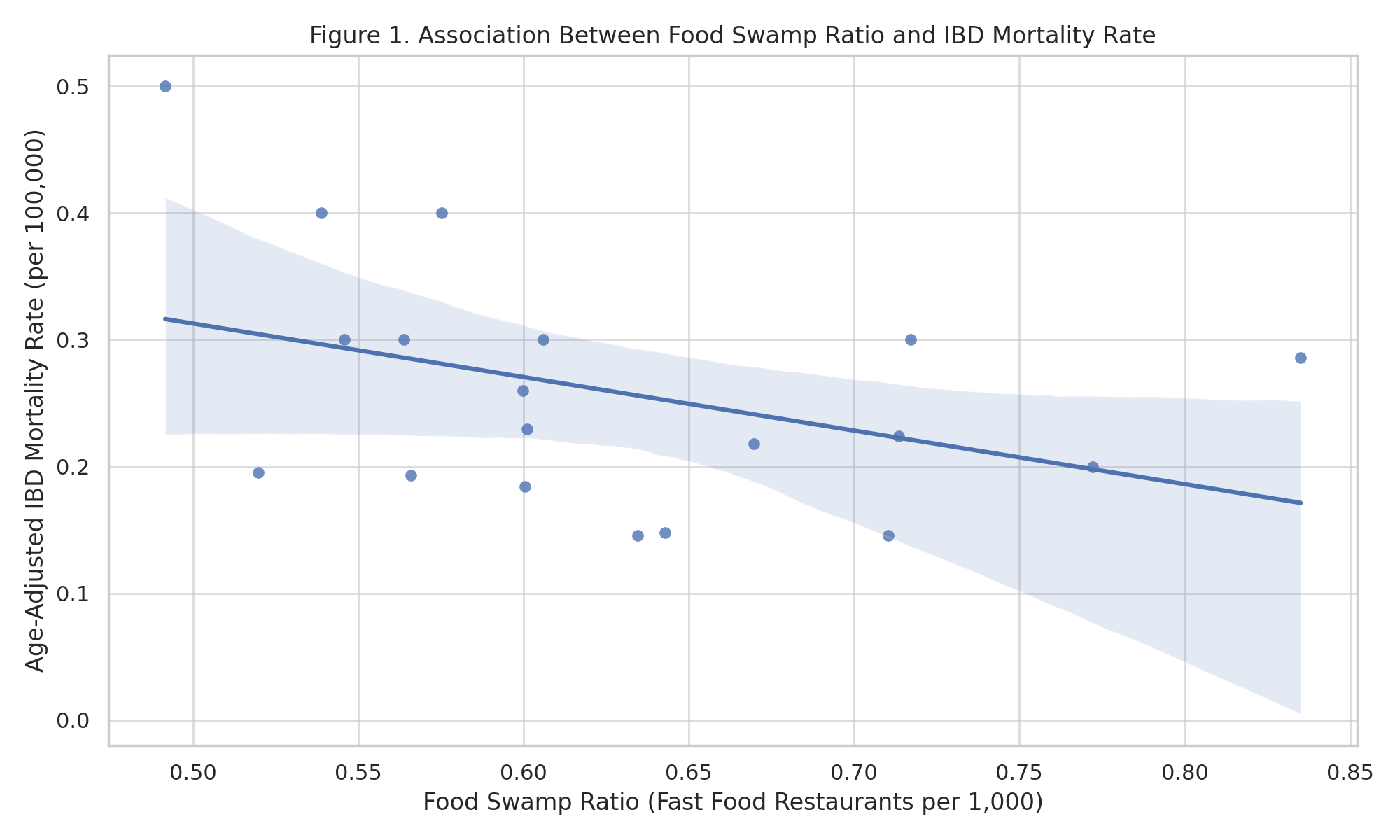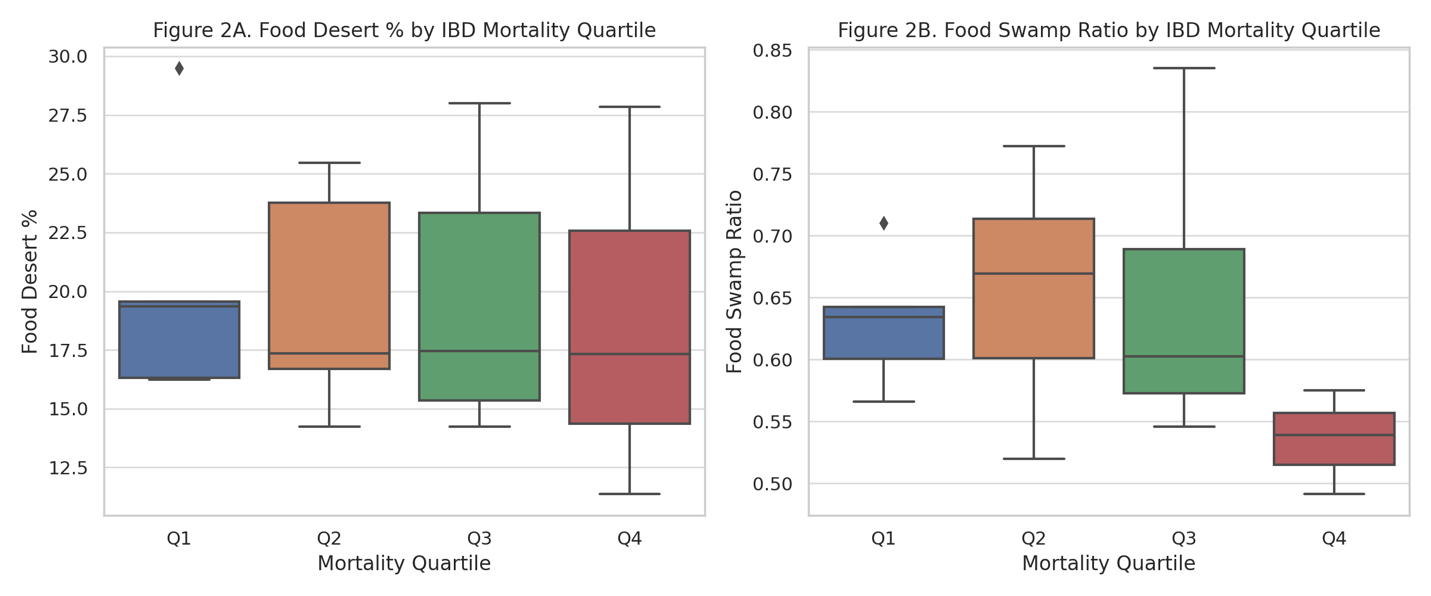Sunday Poster Session
Category: IBD
P1145 - Food Swamps and Food Deserts Impact on Inflammatory Bowel Disease-Related Mortality Across US Counties
Sunday, October 26, 2025
3:30 PM - 7:00 PM PDT
Location: Exhibit Hall

Harsimran Kalsi, MD (she/her/hers)
University of Central Florida
Gainesville, FL
Presenting Author(s)
Harsimran Kalsi, MD1, Joseph Sleiman, MD2, Hassam Ali, MD3, Mehak Bassi, MD4, Aline Charabaty, MD, FACG5
1University of Central Florida, Gainesville, FL; 2Cleveland Clinic, Cleveland, OH; 3East Carolina University/Brody School of Medicine, Greenville, NC; 4Saint Peter's University Hospital / Rutgers Robert Wood Johnson Medical School, New Brunswick, NJ; 5Johns Hopkins University School of Medicine, Washington, DC
Introduction: The role of food environments in inflammatory bowel disease (IBD) outcomes remains under-explored. While food deserts and swamps are linked to metabolic diseases, their association with IBD-related mortality is unclear.
Methods: We performed a cross-sectional ecological analysis of U.S. states using publicly available CDC mortality data (1999–2020) and USDA Food Environment Atlas metrics. Age-adjusted IBD mortality rates were calculated and analyzed alongside 2015 food desert (area lacking accessible, nutritious food) prevalence and 2016 food swamp density (fast-food restaurants per 1,000 residents). States were stratified into quartiles by mortality rates. Associations were assessed using linear regression.
Results: A total of 19 U.S. states with complete data were analyzed. The average IBD-related mortality rate was 0.22 deaths per 100,000 persons. States were divided into quartiles by mortality rate. There was no significant difference in food desert prevalence across quartiles (Q1: 20.2%, Q4: 18.9%, P = NS). However, food swamp exposure was slightly lower in higher mortality states (Q1 mean 0.63 vs Q4 mean 0.54). Linear regression showed a nonsignificant inverse trend between food swamp density and IBD mortality (β = –0.42, P = 0.10), while food desert percentage was not associated with mortality (P = 0.99). These results remained consistent after adjusting for both environmental metrics.
Discussion: Contrary to hypothesized trends, food swamp exposure was lower, not higher in states with higher IBD mortality. These findings challenge conventional assumptions and underscore the need for more granular, patient-level data to understand how food environments may shape IBD outcomes.

Figure: Figure 1. Association between food swamp ratio and age-adjusted IBD mortality rate across 19 U.S. states. A non-significant negative trend was observed (P = 0.10)

Figure: Figure (2A) Food desert percentage by IBD mortality quartile. No consistent trend was noted across quartiles (2B) Food swamp ratio by IBD mortality quartile. States with higher mortality had slightly lower swamp ratios
Disclosures:
Harsimran Kalsi indicated no relevant financial relationships.
Joseph Sleiman indicated no relevant financial relationships.
Hassam Ali indicated no relevant financial relationships.
Mehak Bassi indicated no relevant financial relationships.
Aline Charabaty: AbbVie – Advisory Committee/Board Member, Consultant. Boehringer Ingelheim – Advisory Committee/Board Member, Consultant. Celltrion – Grant/Research Support. Eli Lilly – Advisory Committee/Board Member, Consultant. guardant health – Consultant. Janssen – Advisory Committee/Board Member, Consultant. Pfizer Inc – Advisory Committee/Board Member, Consultant. sanofi – Advisor or Review Panel Member, Consultant. scrubs & heels foundation – co-founder. Takeda – Advisory Committee/Board Member, Consultant.
Harsimran Kalsi, MD1, Joseph Sleiman, MD2, Hassam Ali, MD3, Mehak Bassi, MD4, Aline Charabaty, MD, FACG5. P1145 - Food Swamps and Food Deserts Impact on Inflammatory Bowel Disease-Related Mortality Across US Counties, ACG 2025 Annual Scientific Meeting Abstracts. Phoenix, AZ: American College of Gastroenterology.
1University of Central Florida, Gainesville, FL; 2Cleveland Clinic, Cleveland, OH; 3East Carolina University/Brody School of Medicine, Greenville, NC; 4Saint Peter's University Hospital / Rutgers Robert Wood Johnson Medical School, New Brunswick, NJ; 5Johns Hopkins University School of Medicine, Washington, DC
Introduction: The role of food environments in inflammatory bowel disease (IBD) outcomes remains under-explored. While food deserts and swamps are linked to metabolic diseases, their association with IBD-related mortality is unclear.
Methods: We performed a cross-sectional ecological analysis of U.S. states using publicly available CDC mortality data (1999–2020) and USDA Food Environment Atlas metrics. Age-adjusted IBD mortality rates were calculated and analyzed alongside 2015 food desert (area lacking accessible, nutritious food) prevalence and 2016 food swamp density (fast-food restaurants per 1,000 residents). States were stratified into quartiles by mortality rates. Associations were assessed using linear regression.
Results: A total of 19 U.S. states with complete data were analyzed. The average IBD-related mortality rate was 0.22 deaths per 100,000 persons. States were divided into quartiles by mortality rate. There was no significant difference in food desert prevalence across quartiles (Q1: 20.2%, Q4: 18.9%, P = NS). However, food swamp exposure was slightly lower in higher mortality states (Q1 mean 0.63 vs Q4 mean 0.54). Linear regression showed a nonsignificant inverse trend between food swamp density and IBD mortality (β = –0.42, P = 0.10), while food desert percentage was not associated with mortality (P = 0.99). These results remained consistent after adjusting for both environmental metrics.
Discussion: Contrary to hypothesized trends, food swamp exposure was lower, not higher in states with higher IBD mortality. These findings challenge conventional assumptions and underscore the need for more granular, patient-level data to understand how food environments may shape IBD outcomes.

Figure: Figure 1. Association between food swamp ratio and age-adjusted IBD mortality rate across 19 U.S. states. A non-significant negative trend was observed (P = 0.10)

Figure: Figure (2A) Food desert percentage by IBD mortality quartile. No consistent trend was noted across quartiles (2B) Food swamp ratio by IBD mortality quartile. States with higher mortality had slightly lower swamp ratios
Disclosures:
Harsimran Kalsi indicated no relevant financial relationships.
Joseph Sleiman indicated no relevant financial relationships.
Hassam Ali indicated no relevant financial relationships.
Mehak Bassi indicated no relevant financial relationships.
Aline Charabaty: AbbVie – Advisory Committee/Board Member, Consultant. Boehringer Ingelheim – Advisory Committee/Board Member, Consultant. Celltrion – Grant/Research Support. Eli Lilly – Advisory Committee/Board Member, Consultant. guardant health – Consultant. Janssen – Advisory Committee/Board Member, Consultant. Pfizer Inc – Advisory Committee/Board Member, Consultant. sanofi – Advisor or Review Panel Member, Consultant. scrubs & heels foundation – co-founder. Takeda – Advisory Committee/Board Member, Consultant.
Harsimran Kalsi, MD1, Joseph Sleiman, MD2, Hassam Ali, MD3, Mehak Bassi, MD4, Aline Charabaty, MD, FACG5. P1145 - Food Swamps and Food Deserts Impact on Inflammatory Bowel Disease-Related Mortality Across US Counties, ACG 2025 Annual Scientific Meeting Abstracts. Phoenix, AZ: American College of Gastroenterology.
